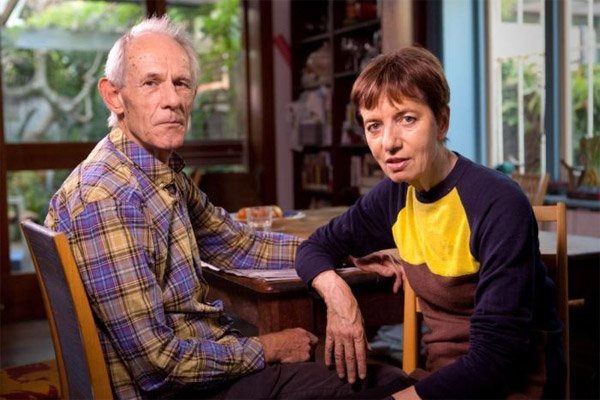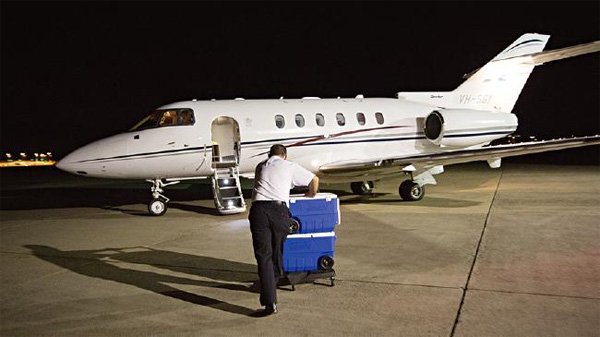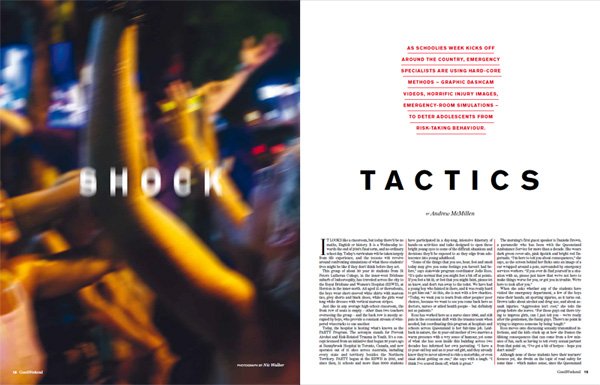Thursday, 24 November 2016
Welcome to Dispatches, a weekly summary of my writing, listening and reading habits. I'm Andrew McMillen, a freelance journalist and author based in Brisbane, Australia.Words:
I had a feature story published in Good Weekend on Saturday. Excerpt below.Shock Tactics (3,200 words / 16 minutes)To read the full story, visit Good Weekend's website, where you can also see a short film by photographer Paul Harris that was recorded on the day we attended the P.A.R.T.Y. program.
As Schoolies Week kicks off around the country, emergency specialists are using hard-core methods – graphic dashcam videos, horrific injury images, emergency-room simulations – to deter adolescents from risk-taking behaviour.
It looks like a classroom, but today there'll be no maths, English or history. It is a Wednesday towards the end of 2016's final term, and no ordinary school day. Today's curriculum will be taken largely from life experience, and the lessons will revolve around confronting simulations of what these students' lives might be like if they don't think before they act.
This group of about 30 year 10 students from St Peters Lutheran College, in the inner-west Brisbane suburb of Indooroopilly, has travelled across the city to the Royal Brisbane and Women's Hospital (RBWH), at Herston in the inner-north. All aged 15 or thereabouts, the boys wear short-sleeved white shirts with maroon ties, grey shorts and black shoes, while the girls wear long white dresses with vertical maroon stripes. Just like in any average high-school classroom, the front row of seats is empty – other than two teachers overseeing the group – and the back row is mostly occupied by boys, who provide a constant stream of whispered wisecracks to one another.
Today, the hospital is hosting what's known as the PARTY Program. The acronym stands for Prevent Alcohol and Risk-Related Trauma in Youth. It's a concept licensed from an initiative that began 30 years ago at Sunnybrook Hospital in Toronto, Canada, and now operates out of 15 sites across Australia, including every state and territory besides the Northern Territory. PARTY began at the RBWH in 2010, and since then, 51 schools and more than 3000 students have participated in a day-long, intensive itinerary of hands-on activities and talks designed to open these bright young eyes to some of the difficult situations and decisions they'll be exposed to as they edge from adolescence into young adulthood.
"Some of the things that you see, hear, feel and smell today may give you some feelings you haven't had before," says statewide program coordinator Jodie Ross. "It's quite normal that you might feel a bit off at points. If you feel a bit ill, or feel that you might faint, please let us know, and don't run away to the toilet. We have had a young boy who fainted in there, and it was really hard to get him out." At this, she is met with a few chuckles. "Today, we want you to learn from other peoples' poor choices, because we want to see you come back here as doctors, nurses or allied health people – but definitely not as patients."'
How I found this story: This one has been on my long list of feature story ideas for several years, I believe, so I can't remember where I first heard about the Australian version of the P.A.R.T.Y program. But I was always captivated by the idea of tagging along as teenagers visited a hospital for a day of hands-on learning about preventing trauma, as I thought it'd provide a great insight into how adults can reframe risk-taking behaviour for young minds grappling with puberty and social pressures. It was a great day, with plenty of learning opportunities for the students I shadowed, and I hope I was able to capture the program's efficacy on the page.
Sounds:

A Sense Of Self on Four Corners (57 minutes). A remarkable, intimate film about the private struggle of one of Australia's top broadcast journalists, Liz Jackson, who here reveals her diagnosis of Parkinson's disease, as well as several interrelated neurological disorders and conditions. It's a captivating, beautiful and painful portrait of her deterioration, and of the love she shares with her filmmaker husband, Martin Butler. A must-watch.
When acclaimed TV journalist Liz Jackson is diagnosed with Parkinson's disease, crippling her with pain & panic attacks, she turns the lens on herself to make the most challenging story of her life.
One Last Thing Before I Go on This American Life (60 minutes). A great episode in two parts, but I was particularly taken by act one, which is about a "wind telephone" that has attracted thousands of bereaved Japanese people, as it allows them to step inside a phone booth and say things that they might've been unable – or unwilling – to say to their loved ones before they were swept away in the 2011 tsunami.
Words can seem so puny and ineffective sometimes. On this show, we have stories in which ordinary people make last ditch efforts to get through to their loved ones, using a combination of small talk and not-so-small talk.
Tim Minchin on Wilosophy with Wil Anderson (75 minutes). To break up a couple of death-centric recommendations: this is a fun chat with a funny Australian musician and performer. It's a typically rambling and entertaining conversation, about everything and nothing in particular.
Getting Wilosophical with Tim Minchin
When I Die: Lessons from the Death Zone by Philip Gould (9 minutes). A beautiful film that was captured during the final weeks of a man's life, whereby he had come to accept his impending death rather than fight against it.
In "When I Die" Philip Gould shares his thoughts and insights as he confronts his impending death from oesophageal cancer. How do we approach death whilst embracing life? How can we change the conversation around death and palliative care for the terminally ill? Philip believed that for the terminally ill and those close to them, there can be moments of joy, resolution and inspiration just as intense as those of fear, discomfort and sadness.
The Simpsons Writers' Reunion on Serious Jibber-Jabber with Conan O'Brien (81 minutes). Simple premise: grab a handful of the original writing team from the funniest TV show of all time, and bring them together for our benefit, to tell stories and laugh about the origins of particular scenes, characters and gags. A joy to watch.
Conan hosts a rollicking round table with fellow writers from "The Simpsons."
Luke Dittrich on Longform (56 minutes). A great conversation about the research and revelations that powered Dittrich's first book, Patient H.M., which is about the most studied individual in the history of neuroscience, "a human guinea pig who would teach us much of what we know about memory today". To complicate matters, the patient is intertwined in Dittrich's family history, as his grandfather was the neurosurgeon who operated on him. I've yet to read the book, but after hearing this interview, I'm very much looking forward to it.
Luke Dittrich is a contributing editor at Esquire. His new book is Patient H.M.: A Story of Memory, Madness, and Family Secrets: "As soon as I told [my mom] that I got my first book deal for this story about Patient H.M., her first words were, "Oh no.' That was sort of her gut reaction to it because, I think, she knew at a certain level that I was going to be dredging up very painful stories. And I think at that point even she didn't know the depth of the pain that some of the stories that I was going to find were going to lay out there."
Reads:

From Heartbreak To Hope by Trent Dalton in The Weekend Australian Magazine (3,500 words / 17 minutes). This story from last July popped up in my Twitter feed this week for some reason, and I couldn't resist revisiting it, as it's as close to a perfect magazine yarn as you'll find anywhere. Built on incredible access and careful observation of the many, many moving parts required to transplant organs from a dying person to a live one, every sentence sings. Reading this kind of story makes me want to be a better writer, and a better person. A masterpiece.
Obama Reckons With A Trump Presidency by David Remnick in The New Yorker (10,800 words / 54 minutes). For my mental health, I've done my best to tune out of American politics since the news of a few weeks ago. It's been good; no regrets. But when I saw that The New Yorker's editor had somehow produced a mammoth profile of President Obama in the immediate wake of Trump's election, there's no way I wasn't eating up every word as quickly as possible. I'd be fascinated to know the inner mechanics of just how Remnick and his team were able to turn this one around so quickly. Brilliant, insightful work.The bittersweet and beautiful truth of the miracle is that for it to begin, this tender, soft-voiced husband must first let go of his wife's hand. Her brain is dead but her hand is still warm because a ventilator pushes oxygen and blood through her body that reclines, eyes closed, on a hospital bed in a North Queensland intensive care unit. Such a simple human movement – relax your fingers, one, two, three, four, five, let go – if not for love and marriage and parenthood and a shared adult lifetime, where her face and all the comfort and meaning it brought was the dominant image in his waking world view. While ICU doctors and nurses discreetly monitor readings around the bed, the husband tells stories about her, remembers things. He talks about their children, their work, their love. "We've had some really good years together," he says. His past 24 hours have been the worst of his life, a harrowing fever dream of emergency medical assistance, bad news to hear and bad news to give. He's barely had time to process the acute brain injury his wife suffered and now he's processing his last goodbye.
Style Councillors by Romy Ash in The Saturday Paper (2,000 words / 10 minutes). I loved this hilarious profile of retro-obsessed Melbourne pop duo Client Liaison, which seeks to answer the question of whether they're actually living inside an enormous performance art piece, or simply taking the piss.The morning after Donald Trump was elected President of the United States, Barack Obama summoned staff members to the Oval Office. Some were fairly junior and had never been in the room before. They were sombre, hollowed out, some fighting tears, humiliated by the defeat, fearful of autocracy's moving vans pulling up to the door. Although Obama and his people admit that the election results caught them completely by surprise–"We had no plan for this," one told me–the President sought to be reassuring. "This is not the apocalypse," Obama said. History does not move in straight lines; sometimes it goes sideways, sometimes it goes backward. A couple of days later, when I asked the President about that consolation, he offered this: "I don't believe in apocalyptic–until the apocalypse comes. I think nothing is the end of the world until the end of the world."
A Strange High: Two Days at Denver's Crypto-Cannabis Conference by Bailey Reutzel on CoinDesk (2,800 words / 14 minutes). A fine and fittingly skeptical dispatch from inside the Bitcoin/blockchain bubble, where snake oil salesmen can sometimes be difficult to detect, especially if you're a little stoned while reporting.The first thing Harvey Miller AO does as I get into the limousine is lean forward, clasp his hands together, and apologise. "Forgive us for the LCD TV," he says. "We're in the process of retrograding the technology. It's to be replaced with an old-school TV, and we're also looking to get a hot towelette machine." Monte Morgan, who is sitting beside me, chips in at this point. "Yeah, so when you arrive you can clean your face, freshen up. Duck Hunt, yeah, we want to get Duck Hunt on an old TV." Client Liaison's white limousine picks me up at my door, taking up a stretch of suburban street. As we pull out from the gutter, Monte, the band's frontman, cracks me a warmish Foster's. There's a wooden heart-shaped table in the centre of the limo, with a champagne cooler stuck in the middle. The table is reminiscent of a nautical interior. The champagne glasses hang from indents built into the wood and swing with the movement of the vehicle.
Neon Liberalism by Gillian Terzis in The Saturday Paper (1,300 words / 7 minutes). I liked this travel story about visiting Las Vegas and exploring its history through Terzis's insightful eyes. "To ask why it was built in a landlocked state in arid desert is to ask the wrong question," she writes. "'Why not' appears to be the governing ethos." I also liked her visit to the 'neon boneyard' and her succinct description of how neon signs were built, before the technology was usurped by LEDs.Hungover. Trying to motivate myself to drive from Colorado Springs to Denver for the second annual Crypto-Cannabis conference. It's 1 pm. Chris Derose messages me: "This conference is weird!" "How so?" "Well, there's a lot of bitcoin pumping, with newbs. And this porn star is getting trashed. Shitfaced." "I should be there. I'm headed up." "There's tons of beer, too much beer. And people are taking smoke breaks. It's not a big crowd." Soda water. Cigarettes. And go. And did they get you to trade your heroes for ghosts? Hot ashes for trees? Hot air for a cool breeze? Pink Floyd. Seems fitting as more and more of the bitcoin industry gets co-opted by corporate interests. Even Bitcoin Core developers – Hearn, Grigg, Garzik – are leaving the volunteer work to join startups for the incumbents now. I'm going as a bitcoin skeptic. No. Not that. Bitcoin is working, although more speculative than a woman without the will to day trade cares for. But it's working. Blockchain, though… That I'm skeptical about that. I won't be alone. Derose is vehemently so. Blockchain isn't a revolution. We're just two lost souls swimming in a fishbowl. Year after year.
I like to say I went to Vegas to escape my material reality. What I mean to say is that I wanted to escape San Francisco. I was underemployed and it was the Labour Day holiday, an unpleasant reminder of my negative net present value. My odds of securing a lucrative job appeared to be lengthening because no one wanted what I was selling. So I sought out Vegas, its diametric opposite. It was gluttonous where SF was health-conscious; it was seamy rather than hygienic. But both cities shared commonalities. Gambling was a core trait: the Vegas economy was powered by people who took chances on luck with real capital, while SF was fuelled by bets on revenue and potential investments that had yet to materialise. Another aspect shared was how both cities traded on the promise of reinvention. The tourism tagline "What happens here, stays here" was devised in 2003 by advertising agency R&R Partners in an attempt to diversify the city's reputation as something other than a garish gambling haven. While people overwhelmingly travel to Las Vegas to gamble, they also associate the city with a state of being.
Thanks for reading. If you have feedback on Dispatches, I'd love to hear from you: just reply to this email. Please feel free to share this far and wide with fellow journalism, music, podcast and book lovers.
Andrew
--
E: [email protected]
W: http://andrewmcmillen.com/
T: @Andrew_McMillen
If you're reading this as a non-subscriber and you'd like to receive Dispatches in your inbox each week, sign up here. To view the archive of past Dispatches dating back to March 2014, head here.
